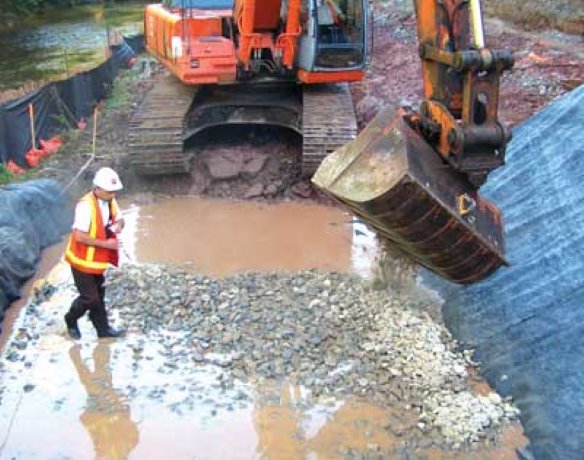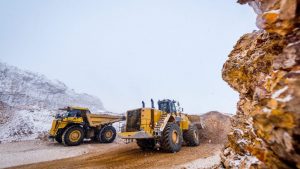After a regulatory approval process that took three years to obtain, a $6-million two-year reconstruction of one the Greater Toronto Area’s most scenic and environmentally-sensitive tourist roads is now in full swing.
Rehabilitation
After a regulatory approval process that took three years to obtain, a $6-million two-year reconstruction of one the Greater Toronto Area’s most scenic and environmentally-sensitive tourist roads is now in full swing.
Fermar Paving Limited is the general contractor overseeing the reconstruction and rehabilitation of the Forks-of-the-Credit Road in the Town of Caledon.
The project involves the excavation and engineered slope stabilization of four sections of this winding and twisting road that extends from Highway 10 to Belfountain, a picturesque hamlet that attracts scores of visitors every weekend.
Named after the juncture of two branches of the Credit River — thus the name Forks — which it crosses, the road passes underneath a 350-metre-long CPR trestle. Motorcycle riders like its twists and turns and in the fall visitors use it to watch the changing colours.
But it’s also an over used and under built road that it’s in danger of slipping into the Credit River, says Caledon Councillor Richard Paternak.
While there are other routes into Belfountain, the closure of the road will have an impact on local businesses, the councillor concedes.
However, the project couldn’t have been delayed any longer, says Paternak.
“We had to bite the bullet sometime or the entire road might have been underpinned and there would have been a catastrophe waiting to happen.”
A geotechnical report conducted for Peel Region, which maintains the road, confirmed the need for the project.
But it took almost three years to obtain regulatory approval from the Niagara Escarpment Commission, the Credit Valley Conservation Authority, the Ministry of Natural Resources and the Department of Fisheries and Oceans, says Paternak.
It was the region’s operations staff who initially recommended the reconstruction after several years of temporary repair work trying to rectify the unstable conditions, says Randy Senko, a project manager with the region’s engineering and construction department.
“It’s an old logging road, and there’s material there that shouldn’t be there. We’re stabilizing the slope edge of the road because it is basically falling into the Credit River in two locations and into wetlands in two other spots.”
Work on the first section began in early August when the river was at it lowest and when there will be the least possible impact on fish habitat, says Senko.
“We had to be out of the water by September 15,” says Fermar superintendent Steven Clay, referring to Ministry of Natural Resources regulations.
Along this 90-metre-long section, Fermar has built an engineered slope that was designed by Brampton-based Trow Associates and is comprised of a SierraScape Wire-Formed Retaining Wall System.
A temporary cofferdam had to be installed to prevent material and debris from slipping into the river and then the road had to be excavated five metres deep — of which one metre was below the water line.
The road was then rebuilt to its original height using several boulders that were saved from the excavated material, plus numerous two- to six-inch diameter stones and about 6,000 to 7,000 tons of new granular backfill, says Clay.
As there is little room for trucks to maneuver on the narrow winding road, one of the challenges was trucking away the approximately 350 loads of original road base, he says.
“Our biggest challenge though has been to keep out cyclists. It’s an unsafe area.”
While there are numerous signs warning the road is close to all users, with the exception of local residents, that hasn’t deterred some cyclists and hikers from venturing along the road, says Clay.
The reconstruction of the first section was completed on Sept. 30 and the Fermar crews have now moved to a second site.
While this second site is away from the river, there are still some environmental restrictions and there is a need for extra safety precautions as the site is close to a railway line, he says. Work will last until December.
Second phase reconstruction of the two remaining sites will begin in May 2007.











Recent Comments
comments for this post are closed